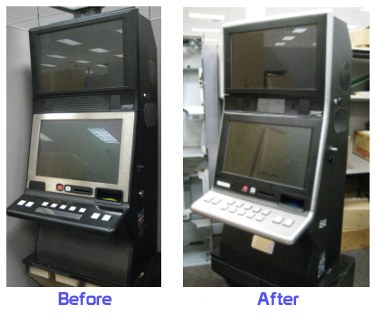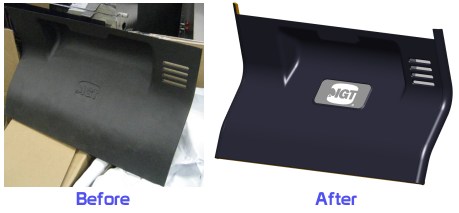 |
| January 08, 2013 | Volume 09 Issue 01 |
Designfax weekly eMagazine
Archives
Partners
Manufacturing Center
Product Spotlight
Modern Applications News
Metalworking Ideas For
Today's Job Shops
Tooling and Production
Strategies for large
metalworking plants
Engineer's Toolbox:
Doubling down with DFMA; slot machine gets radical redesign and accelerated assembly

Flashing lights, digitally generated sounds, and constantly changing video images keep slot machine players engaged in a fast-paced rhythm on casino floors everywhere. A fast pace is equally appreciated and sought after by the engineers who design and manufacture the slots.
Speed counts, and it's a tough production task given the complexity of the machines. It's vital to keeping costs down, too. "As engineers, we continually ask ourselves, 'what can we do to make the product move more quickly through our processes and get to the market and our customers faster?'" says Sam Mikhail, staff engineer at International Game Technology (IGT; Reno, NV).
It's an important question at IGT, and it's asked often. Beyond appearance and game type, the need for configuration of components as ordered by the customer drives a great deal of how slots are made and what technology goes inside. IGT slots are sold worldwide, and different regulations impact the configuration of machines ordered. Some casinos require special security for entry points on the cabinet. Others want specific peripheral brands for standardization in order to reduce replacement inventory for items such as ticket printers, bill validators, or card readers.
From a business viewpoint, accommodating all these variances is vital. From a design and manufacturing standpoint, this increases the challenges for the engineers, since configuration can affect standardization of components, the speed of building the machine, and costs.
Recently, IGT management requested that engineers improve and streamline the configuration of the popular G20 series slot machine into G20 Version 2. Mikhail approached the assignment as an opportunity to reconsider the role played by each internal component in the system. "Through a redesign you can achieve unexpected efficiencies," he says. So, instead of just "tweaking" an already well-designed product, the team was encouraged to ask, "How can we make this much better?" This approach ultimately produced a radical redesign of an existing product and proved the value of utilizing Design for Manufacture and Assembly (DFMA) software from Boothroyd Dewhurst, Inc. (Wakefield, RI).
The road to radical redesign
Mikhail, a champion of DFMA for many years, and regular speaker at the DFMA International Conference, had recently introduced the approach into IGT. DFMA software combines Design for Manufacture (DFM) and Design for Assembly (DFA). DFM Concurrent Costing guides engineers early in design to compare the costs of possible alternative materials and processes. DFA software focuses on part-count reduction, enabling engineers to create simplified, elegant designs that meet or exceed the functionality of the original product, while reducing costs.
"For the Version 2.0 redesign we focused on applying the DFA tool," says Mikhail. "That's how we identified and measured our biggest savings." The DFA tool also helped demonstrate to the team the striking success they could achieve once they embraced potentially radical change.
At the project start, Mikhail conducted a teardown analysis of the G20 V.1, identifying sub-assemblies that were good candidates for redesign. This provided a base point for seeking new ideas to improve these areas.
"But the V.1 also restricted our decisions in some important ways." Mikhail says. For one thing, any new assembly had to fit within the predefined constraints of the G20 V.1 cabinet, with its slanted screen and player panel bolster (the "desktop" with the pushbuttons on it). The new machine also had to accommodate many of the existing components that customers wanted for their own customized configurations of the G20.
"Our first look at the G20 was what I'd call a 'soft' look," Mikhail says, "but the more we explored, the more opportunities we saw to go radical." For Mikhail and the other IGT engineers in his team, "going radical" meant reaching far beyond incremental revisions to change the design on an entirely different scale.
"Radical redesign can be uncomfortable, because there's more risk," Mikhail says. "On the other hand, the potential rewards are greater."
For instance, one candidate for a makeover was the lower door and some corresponding parts on the cabinet itself. In the old machine, this comprised 33 components. "We questioned how we can improve the design of the door while reducing part count," Mikhail says. "Out of that discussion came the idea of changing our material to combine more components into the assembly." This drove the team to review each component with the DFMA analysis tool and follow good DFA techniques. "The door itself was die-cast metal," says Mikhail. "But we decided to see if we could make the door out of injection molded plastic and integrate more parts into it."
It was not an easy decision to make. "When you make a radical change, you have to fight the general feeling -- sometimes even your own feeling -- that if a previously made item is working well, then there's no point in changing it. However, you also have to challenge assumptions, 'myths,' about the design," he says. DFA helped the team to look beyond previous practices and focus on their new goals.
In the case of the door, the die-cast version performed a number of functions to comply with electrical, mechanical, and safety requirements. Injection molded-plastic alone might not be sufficient. After conducting rigorous FEA and testing on a number of possible solutions, the team found that a hybrid metal/plastic composite approach satisfied all specifications.
The DFMA analysis tool enabled the team to evaluate which parts were essential and which could be candidates for elimination. The process involved more than one reiteration to reach an optimum design. "Using plastic injection molding allowed us to combine many parts together and incorporate overall functionality so well that we could eliminate a number of parts -- and therefore the need to redesign them," Mikhail says. An added benefit was reduced weight of the new door and a significant reduction in cost.
The rewards of DFMA analysis extended beyond the door assembly itself. For example, the G20 V.1 included side-rails mounted to the cabinet. The analysis highlighted the feasibility of combining the rails with the door while maintaining functionality. "We cut the count for that subassembly from 33 to 4," Mikhail says.

Another application that took advantage of DFA was the decorative rails surrounding the perimeter of the game cabinet. "The rails were mounted to the machine using 32 fasteners; the analysis process suggested that we could eliminate many of them," Mikhail says. "The question was, how could we keep the mounting location and change the mounting method?" An alternative solution was evaluated, and through collaboration with an injection molding vendor, the rails were redesigned to accommodate a specialized snap system. "This eliminated all the fasteners on the rails, along with the time it previously took to attach them to the machine," Mikhail notes.
The snap-fit redesign had another benefit. "Eliminating sink marks on the surface of a decorative rails requires considerable molding expertise," Mikhail says. "Applying innovative design to the snap system, coupled with using advanced injection molding technologies such as sequential valve gate controllers, allowed us to introduce flawless surfaces that took electroplating well and further enhanced the appearance of the cabinet."
Another design objective was the serviceability of the slot machine. Often, for reasons involving available space inside the machine, engineers create layered assemblies in which a top-tier part, or even a number of components, must be removed to reach a part installed behind or beneath others. However, multilayer assembly designs have a great impact on serviceability.
"Because it is critical to our customers not to have games idle on the casino floor," Mikhail says, "we asked ourselves, 'what are the serviceable components, and how can we make it easier for technicians, with the least amount of downtime?'" Putting all components on a single tier ensured that removing them required a minimum of time and effort. "If something isn't working, you can pull it out and slide a new one in," Mikhail says. "The slot machine is then up and running while you troubleshoot the failed component away from the casino floor."
The payout: ease of assembly, serviceability, and customer satisfaction
In the course of the redesign, Mikhail had created a vision for how the slot machine should look, and a roadmap for achieving this. The key foci for the team included single-tier accessibility (instead of the traditional multilayered designs), design efficiency (focusing on overdesigned areas that needed to be de-cluttered), and questioning everything about the original design (the V.1).
"We could not have achieved the success we had with the V.2 without using DFMA," Mikhail says. When the new design was finished, the team ran another full DFMA analysis on the system to capture a before-and-after summary of what they had achieved.
From a manufacturing standpoint, the differences between V.1 and V.2 were striking: assembly time was reduced 50 percent, part count went from about 800 down to 500, and a significant cost reduction was achieved. Even at a company as recognized for its achievements as IGT -- the recipient of the 2012 Operational Excellence award from the Manufacturing Executive organization -- these were impressive results. In fact, some of the radical redesigns on the G20 V.2 are currently being considered for use on new slot machines.
There are also downstream savings, a "ripple effect" caused by part and assembly time reduction. "Fewer parts mean fewer inventories, less inventory management, and fewer purchases," Mikhail points out. In addition, IGT production has been able to reduce several stations in the assembly line as a result of the new design.
Because of the positive results of the G20 redesign, DFMA is now included as a prescribed product development process at IGT.
The G20 V.2 is performing well and is proving highly reliable. And the field results from the service department? "When the G20 V. 2 was done and out the door, I got a phone call from the service trainer," Sam recalls. "Instead of telling me whether or not he liked the new machine, he said, 'Sam, do you know how long it takes to remove all these parts?' I thought, 'Oh, no ...' Then he said, 'Six minutes -- about one-fifth of the time it used to take us.'"
Jackpot!
Want more information? Click below.
Published January 2013
Rate this article
View our terms of use and privacy policy
